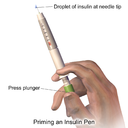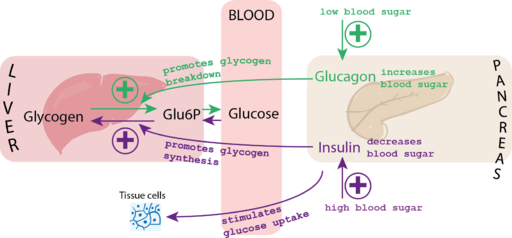Diabetes
NOTE: This assignment has two parts. Please submit the assignment after completing both parts.
It may take you some time to finish the work, please save the draft, Moodle also has an auto save feature, so you can complete the assignment in more than one sitting. Assignment grading is done only once. Please write title and copy/paste questions. (5 Points)
Part 1: Diabetes Introduction & Complications: 30 Points
A: Diabetes Introduction

“Insulin is not a cure for diabetes; it is a treatment. It enables the diabetic to burn sufficient carbohydrates, so that proteins and fats may be added to the diet in sufficient quantities to provide energy for the economic burdens of life.”
— Sir Frederick Grant Banting 'Diabetes and Insulin', Nobel Lecture, 15 September 1925. In Nobel Lectures: Physiology or Medicine, 1922-1941 (1965), 68.
Figure 1.1.6. Insulin Pen by BruceBlaus / Creative Commons Attribution 3.0 Unported
Essential Question:
Do! Q. 1) What happens when the human body is not able to stay in balance? (2 Points)
Watch the following video:
To better understand the regulation of blood sugar in the body, watch this video as well.
Do ! Comprehension Quick Write:
Q. 2) Using complete sentences, please explain negative feedback in the body by describing what is taking place in the image below. Please use the following terms in your explanation: glucose, insulin, glucagon, glycogen, pancreas, liver, increase, decrease, blood. (10 Points)
Q. 3) Describe three differences between Type 1 and Type 2 diabetes. (3 Points)

Figure 1.1.7. Blood Glucose Control by C. Muessig / Creative Commons Attribution-Share Alike 3.0 Unported
B: Complications of Diabetes:
Diabetes affects the body cells’ ability to use glucose. Because cells need glucose for cellular respiration to create cellular energy (ATP), the inability to use glucose (C6H12O6) can lead to cell death. Uncontrolled levels of glucose in the blood can cause complications in the body.
Please use use this online dictionary if you need help defining the word parts below.
Do! Q. 4)
-
hyper- =_________________ hypo- =______________ glycemia = ____________ (3 Points)
-
Hypoglycemia can occur if there is too little glucose (sugar) in the blood. What is a possible treatment for hypoglycemia? (2 Points)
-
Hyperglycemia can occur if there is too much glucose (sugar) in the blood. What is a possible treatment for hyperglycemia? (2 Points)
-
Please watch Julia Roberts in Steel Magnolias: “https://youtu.be/ybbS5_qlkaQ” Is Julia Roberts suffering from hypoglycemia or hyperglycemia? How do you know? (2 Points)
The list below includes some common complications that are associated with diabetes. Define the parts of the word and the specific effect on the body. You will likely need to research by looking at diabetes organizations online, there are lots of them. Another resource is to rewatch the last half of this video: Type 1 vs Type 2 diabetes.
| Diabetes Complication | Word Parts | Effect on Body |
| Cardiovascular Disease | cardio = vascular = |
|
| Gastroparesis | gastro = paresis = |
|
| Neuropathy | neuro = pathy = |
|
| Renal Disease/ Nephropathy | renal = nephro = pathy = |
|
| Retinopathy | retino = pathy = |
|
| Hypertension | hyper = tension = |
Do! Quickwrite:
Q. 5) Do you know someone who has diabetes? If yes, what does that person do to help manage his/her diabetes? If you do not know anyone with diabetes, describe something about diabetes. Please use complete sentences. (3 Points)
Q. 6) Please reflect on what you have learned so far in this lesson and how you have learned it. Add your comments at the end of your assignment submission. (3 Points)
_______________________________________________________________________________________
Part 2: Diabetes Case Study, Sugar and Type 2 Diabetes: 30 Points
Please write minimum 50 or more words in 2 or 3 points questions.
A: Diabetes Case Study
 Please click this link from the University of Wisconsin to determine whether or not Ben has diabetes.
Please click this link from the University of Wisconsin to determine whether or not Ben has diabetes.
Click on the red arrow at the bottom right of the screen to determine whether or not Ben has diabetes. You will be playing the role of Ben’s doctor. You will carefully work through all pages of the exercise.
Do! Questions:
- Describe in a paragraph the negative feedback loop involved in regulating sugar. (2 Points)
- What is the function of insulin in the body and where is it produced? (2 Points)
- What is the normal amount of sugar that should be in the blood about 2 hours after a meal or sugary snack? (1 Point)
- Is Ben's blood sugar level normal after his glucose tolerance test? Explain. (2 Points)
- Describe what is happening in Ben's body that resulted in the abnormal test as explained in #3. (2 Points)
- Does Ben have diabetes? Explain. (2 Points)
- Does Ben need to take insulin? Explain (2 Points)
- What diet recommendations would you make for Ben if you were his doctor? (2 Points)
B: Sugar and Type 2 Diabetes
You have learned the role an value of sugar in the body, but how much sugar do you really need? In this assignment, you will explore this question by watching the video below and doing close reading of a related article.
Video (from Ted-Ed)
Article
Sugar In Diet Linked To Type 2 Diabetes Rates, Study Finds (Huffington Post)
Do! Questions
- Why is it confusing to know exactly if the food you eat includes added sugar or not? Explain ( 2 Points)
- What are the reasons why the food industry adds sugar to food? Explain ( 2 Points)
- What is the World Health Organization limit for grams of sugar per day? (1 Point)
- List what you have eaten so far today and what time it is? Look at labels or research online and predict how many grams of sugar you have consumed so far today? Compare this with the recommended amount of sugar. Do you feel like you stay within this recommended amount on most days? (3 Points)
- Describe a 3 meal plan (breakfast, lunch, and dinner) that you would eat with no added sugar? What would those meals be composed of? (3 Points)
- Do you believe that sugar consumption in the United States is a public health problem? Defend your answer with information that you learned in the video and the article. Provide three statements or data presented in the lesson. (4 Points)